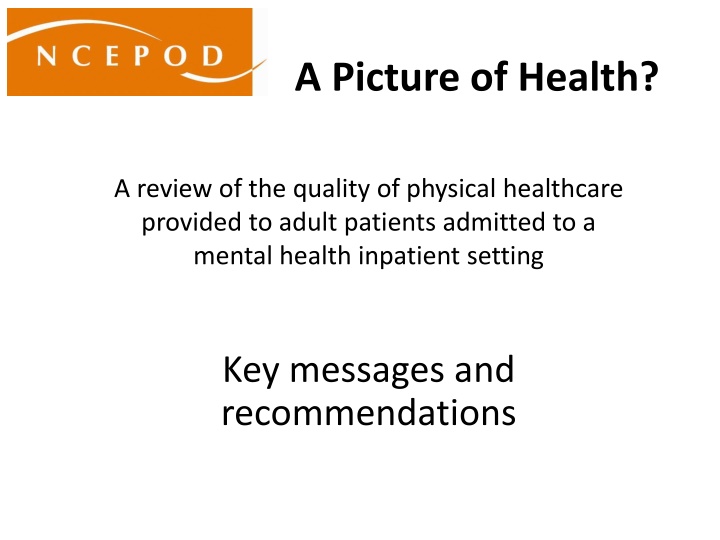
Quality Review of Physical Healthcare in Mental Health Inpatient Setting
Explore a comprehensive study on the quality of physical healthcare for adult patients in mental health inpatient settings, analyzing key messages and recommendations. The research focuses on assessing care, study population demographics, exclusions, and overall quality of care. Key findings highlight the need for improved healthcare provision in mental health wards.
Download Presentation

Please find below an Image/Link to download the presentation.
The content on the website is provided AS IS for your information and personal use only. It may not be sold, licensed, or shared on other websites without obtaining consent from the author. If you encounter any issues during the download, it is possible that the publisher has removed the file from their server.
You are allowed to download the files provided on this website for personal or commercial use, subject to the condition that they are used lawfully. All files are the property of their respective owners.
The content on the website is provided AS IS for your information and personal use only. It may not be sold, licensed, or shared on other websites without obtaining consent from the author.
E N D
Presentation Transcript
A Picture of Health? A review of the quality of physical healthcare provided to adult patients admitted to a mental health inpatient setting Key messages and recommendations
The study A review of the quality of physical healthcare provided to adult patients admitted to a mental health inpatient setting Trust level Organisational questionnaire Hospital level Organisational questionnaire Clinician questionnaire Case note review
The study Anonymous open access online surveys for - Healthcare professionals working in mental health inpatient settings - Patients - Carers
Study population Adults aged 18 years and older who were admitted to a mental health inpatient setting for a period of more than one week during the study period of 1st November 2018 to 31st October 2019, and who had one or more of the following concomitant physical health conditions* recorded on discharge from the mental health facility: Chronic obstructive pulmonary disease/asthma Cardiovascular disease Diabetes OR: The physical health condition of the patient necessitated an acute transfer to a physical health hospital for assessment/ treatment/ stabilization OR: The patient died in the mental health inpatient setting or within 30 days of discharge from the mental health inpatient setting
Study population Exclusions Suicides, homicides and self-harm related deaths as this group of patients is covered by the National Confidential Inquiry into Suicide and Safety in Mental Health (NCISH) Patients in hospitals who were part of tertiary commissioned services these encompassed patients with dementia, other organic brain injury or learning disability not in conjunction with any other mental health condition
Overall assessment of care Figure 12.2 Overall quality of care Case reviewer data
Key messages (1) Assess patients for acute physical health conditions on arrival at a mental health inpatient setting and then undertake a detailed physical health assessment once the patient is admitted Patients admitted for mental healthcare but who are also physically unwell need complex care. Patients may need a transfer to a physical health hospital for an acute condition, and/or they may have at least one long-term physical health condition that needs monitoring. Physical health conditions were not included in the initial clerking for 29/150 (19.3%) patients and a detailed physical health assessment was not undertaken appropriately for 28/126 (22.2%) patients.
Key messages (2) Develop a physical healthcare plan for patients admitted to a mental health inpatient setting The ongoing physical healthcare of patients should be monitored to prevent deterioration. A plan for physical health observations was not documented for 48/217 (22.1%) patients and no advice was given about who should be notified in the event of physical health concerns for 47/169 (27.8%) patients. Physical healthcare plans were formulated for only 155/291 (53.3%) patients.
Key messages (3) Formalise clinical networks/pathways between mental healthcare and physical healthcare Mental healthcare staff need support in providing physical healthcare. There were 127/268 (47.4%) mental healthcare professionals surveyed who reported feeling fairly / less than fairly confident or competent in caring for patients with long-term conditions and 216/317 (68.1%) thought there was scope for improvements in the hospital s networks with local physical healthcare providers. Local care pathways or pre-existing arrangements with physical healthcare providers were used as part of the care plan for 71/291 (24.4%) patients in this study.
Key messages (4) Involve patients and their carers/friends/family in their physical healthcare and use the admission as an opportunity to assess, and involve patients in their general health Hospital admissions are an excellent opportunity to assess and help improve a patient s general physical health and including family/carers can be a great form of support. There were 15/29 organisations with a physical health strategy that had a specific commitment to improve communication about physical health with patients and carers. However, there was no record that the findings of the physical health review had been discussed with the patient s family/carers in 100/188 (53.2%) sets of notes reviewed.
Key messages (5) Include mental health and physical health conditions on electronic patient records and allow sharing across healthcare providers Effective electronic patient records (EPR) for physical as well as mental health, should be shared across providers, to improve patient safety and make communication easier. While all organisations apart from one had some form of EPR system, only 20/56 reported that all elements of the clinical record were available on it and only 244/405 (60.2%) clinicians using the systems thought the EPR allowed easy viewing/input of the patient s physical health needs.
Recommendation 1 On arrival at a mental health inpatient setting, check if the patient faces any acute risks to their physical health, including physical health risks associated with rapid tranquilisation and take appropriate action. Target audience: Mental healthcare professionals and receiving mental health ward medical and nursing staff
Recommendation 2 On admission to a mental health inpatient setting, carry out and record an initial physical health assessment on all patients. If the patient has the mental capacity to consent to undergo a physical health assessment but refuses, document this then and try again as soon as practicable. This should start within 4 hours* and include: a) Baseline observations including blood pressure, heart rate and respiratory rate and temperature and oxygen saturation Details of existing physical health conditions and any acute changes since the last clinical review Current medication (physical and mental health) including side effects and adherence Whether the patient is at risk of withdrawal from drugs/alcohol Height, weight, relevant blood tests (use recent blood tests if appropriate) and an ECG b) c) d) e)
Recommendation 2 continued f) g) h) i) Hydration status and a fluid balance plan Dietary status, with input from the nutrition team as necessary Review of physical health risks associated with rapid tranquilisation The frequency of repeat physical health observations, relevant to the patient s condition, using the National Early Warning Score (NEWS2) where appropriate Target audience: Mental healthcare professionals with support from allied health professionals
Recommendation 3 Within 24 hours of admission to a mental health inpatient setting, collaboratively develop and document a physical healthcare plan with every patient, based on their initial physical health assessment. Where applicable include: a) The most appropriate healthcare location to treat the patient s physical healthcare needs (e.g. mental health or physical health hospital) b) Monitoring and treatment plans, including: - how frequently to review the physical health risk assessment, recognising acute or chronic health conditions - how often to repeat physical health observations and whether to use early warning tools (National Early Warning Score (NEWS2)) - a nutrition plan c) The physical health support needed
Recommendation 3 continued d) Escalation plans in the event of deterioration (linked to the NEWS2 score) or patient not consenting to be assessed, that include who contact and when e) Identify gaps in clinical history and a plan to address them Target audience: Mental healthcare professionals supported by physical healthcare professionals
Recommendation 4 Within 24 hours of admission to a mental health inpatient setting, pharmacy staff (in the mental health inpatient setting, and where involved, in the physical health hospital) should undertake a full medicines reconciliation, including all medications for physical as well as mental health. Target Audience: Pharmacy staff in mental health inpatient settings and physical health hospitals
Recommendation 5 Develop and implement an organisational policy and protocol to ensure that patients in a mental health inpatient setting are properly assessed, and treated, for physical health conditions in a considerate and collaborative manner. This could be done by: a. Formalising existing clinical networks or pathways for diagnosing or treating common acute conditions for example, infection or existing long-term conditions b. Training registered mental health nurses, healthcare assistants, or any other staff as appropriate to monitor and support the management of common long-term physical conditions, while ensuring their competencies are well defined and are kept up to date c. Collaborating with local physical health hospitals to develop a physical health liaison service Target audience: Mental health executive boards and physical health executive boards supported by commissioners
Recommendation 6 Develop and implement an organisational policy and protocol for the transfer to, and readmission from, a physical health hospital to a mental health inpatient setting. This should include: a. A comprehensive clinical summary which includes, but is not limited to: - Physical and mental health condition(s) - Current physical and mental health care plans - Physical and mental health medications - Monitoring and escalation plans - A mental health capacity assessment and the status of mental health legislation (if applicable)
Recommendation 6 continued b. Prompt treatment in the physical health hospital c. A plan for readmission to the mental health inpatient setting developed by the physical and mental healthcare teams working together. Include: - The estimated date of discharge and return to the original mental health ward - The planning for physical healthcare provision that goes beyond what is available in the mental health inpatient setting d. A record of transfers to a physical health hospital due to a deterioration in the physical health of a patient this should be regularly audited for unexpected transfers Target audience: Mental health executive boards and physical health executive boards supported by commissioners and all healthcare professionals
Recommendation 7 Develop and implement an organisational policy and protocol to involve patients, carers/friends/family in the patient s physical healthcare. This could include: a. Enabling carers/family/friends to provide staff on the ward with information about the patient s physical health b. Access to clear information on what general physical health assessments are carried out when a patient is admitted to the ward c. Access to: - Healthy lifestyle advice - How family/friends/carers can support good physical health
Recommendation 7 d. Ensuring that with patient consent, patients and their carers/family/friends can: - Receive updates on the patient s physical health including transfers to physical healthcare settings - Ask questions about the patient s physical health needs - Contribute to the development of and/or receive a copy of the patient s physical healthcare plan - Receive clear information about any post-discharge follow-up physical health plans Target audience: Mental health executive boards and mental healthcare professionals, associated patient involvement groups
Recommendation 8 Use admissions to a mental health inpatient setting as an opportunity to assess and involve patients in their general health. A hospital policy, supporting training in a range of health improvement topics for staff who work directly with patients, could include: a. Exercise b. Diet c. Smoking cessation d. Alcohol use e. Substance use f. Sexual and reproductive health g. Immunisation h. Routine NHS screening programmes Target audience: Mental health executive boards and physical health executive boards supported by commissioners
Recommendation 9 Offer support to patients admitted to a mental health inpatient setting who smoke tobacco, drink alcohol at harmful or dependent levels, or use other drugs. Use defined substance misuse pathways and where needed, include: a. Assessment and screening tools b. Specialist advice c. Interventions and prescribed treatment (especially for dependence) d. Follow-up after discharge, supported by the local alcohol or drugs recovery services (local health authority commissioned services) Target audience: Mental healthcare professionals, local authorities and commissioners
Recommendation 10 Record the correct physical health diagnosis, ICD 10/ SNOMED CT codes (or equivalent) in mental health clinical records and discharge summaries. Target audience: Mental healthcare professionals, hospital coders
Recommendation 11 Ensure that electronic patient records in mental health inpatient settings: - Have the functionality to record physical health conditions - Have the facility for tasks to be set to aid disease and treatment monitoring - Are accessible, to allow handover between clinical teams and across healthcare providers Target audience: Mental health executive boards, IT departments and providers of electronic patient record systems supported by NHS Digital, NHS Wales Informatics Service, Northern Ireland Statistics and Research Agency
Recommendation 12 Provide a discharge summary to the patient, their carer/s, GP and community mental health team within 24 hours of discharge. This should include: - Mental and physical health diagnoses - All medications for mental and physical health, including who will provide them and the reason for any prescription changes - Follow-up arrangements with the community mental health team/GP - Mental health and physical health care plans - Any support needed to carry out the care plans Target audience: Mental healthcare professionals
Discussion Are patients being checked on arrival to an inpatient mental health ward for any acute risks to their physical health? Is a initial physical health assessment carried out for patients on admission to an inpatient mental health ward? Has a collaborative physical health care plan been created for each patient with physical health needs Has a full medicines reconciliation been carried out within 24 hours? Is each admission used as an opportunity to improve physical health Does the organisation have policies / protocols covering the assessment / treatment of the physical health of patients; transfer (if necessary to a physical health care setting; involvement of patients and carers in the patient s physical health care Does the organisation have an electronic patient record that allows audit/ coding of physical health conditions?
A Picture of Health? A Picture of Health? Full report, summary and implementation tools are be found at https://ncepod.org.uk/2022phmh.html













